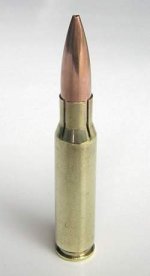What's going on here?
I am trying to develop a load for my 338-06 using Barnes 160 grain TTSX. Using info I received from Barnes I performed a ladder test staring at the min and progressing to the max in .01 grain incriminates. During the ladder test I saw no signs of pressure with any load. I settled on 61.3 of H 335 (best node) and began testing seating depth. Using a bullet comparator I seated the bullets at 3.595 to 3.635 in incriminates of .005, and loaded 3 of each.
Started shooting the shorter bullets first (3.595) and progressed to the longest (3.635). Everything was going as it should (no signs of pressure) until I got to the final six. The first three were a little tight ejecting and the final two I shot blew out the primers. Stopped right there! Keep in mind I shot these very same loads without any problems not more than 20 minutes prior to blowing the primers out. Any ideas as to why this is happening?
Here are the details for the loads
Remington Brass (30-06 new and resized)
Winchester WLR primer
Barnes TTSX 160 grain bullets
H335 powder (61.3 grains)
Barnes Manual states min to max are 57.0- 62.0 of H335
All measurements given are to the Ogive of the seated bullet.
I am trying to develop a load for my 338-06 using Barnes 160 grain TTSX. Using info I received from Barnes I performed a ladder test staring at the min and progressing to the max in .01 grain incriminates. During the ladder test I saw no signs of pressure with any load. I settled on 61.3 of H 335 (best node) and began testing seating depth. Using a bullet comparator I seated the bullets at 3.595 to 3.635 in incriminates of .005, and loaded 3 of each.
Started shooting the shorter bullets first (3.595) and progressed to the longest (3.635). Everything was going as it should (no signs of pressure) until I got to the final six. The first three were a little tight ejecting and the final two I shot blew out the primers. Stopped right there! Keep in mind I shot these very same loads without any problems not more than 20 minutes prior to blowing the primers out. Any ideas as to why this is happening?
Here are the details for the loads
Remington Brass (30-06 new and resized)
Winchester WLR primer
Barnes TTSX 160 grain bullets
H335 powder (61.3 grains)
Barnes Manual states min to max are 57.0- 62.0 of H335
All measurements given are to the Ogive of the seated bullet.

